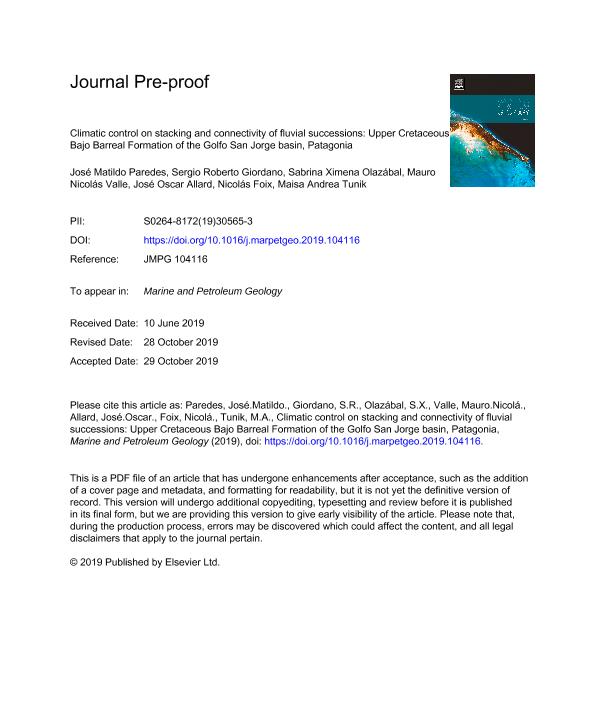Artículo
Climatic control on stacking and connectivity of fluvial successions: Upper Cretaceous Bajo Barreal Formation of the Golfo San Jorge basin, Patagonia
Paredes, José Matildo; Giordano, Sergio Roberto; Olazábal, Sabrina Ximena; Valle, Mauro Nicolás ; Allard, José Oscar; Foix, Nicolas
; Allard, José Oscar; Foix, Nicolas ; Tunik, Maisa Andrea
; Tunik, Maisa Andrea
 ; Allard, José Oscar; Foix, Nicolas
; Allard, José Oscar; Foix, Nicolas ; Tunik, Maisa Andrea
; Tunik, Maisa Andrea
Fecha de publicación:
03/2020
Editorial:
Elsevier
Revista:
Marine And Petroleum Geology
ISSN:
0264-8172
Idioma:
Inglés
Tipo de recurso:
Artículo publicado
Clasificación temática:
Resumen
Climate impact on alluvial organization owing to its control on water availability and sediment delivery within the catchment, but temporal changes in stacking patterns are often interpreted to reflect changes in subsidence and base level. To test for evidence of climatic control on the stacking pattern, we study an outcrop succession with two styles of stacking within the Upper Cretaceous Bajo Barreal Formation in the Cerro Ballena anticline, Golfo San Jorge Basin, Argentina. The 385 m thick and 2.5 km wide exposure has layer-cake geometry, lacking either large-scale erosional surfaces, fluvial terraces, or evident paleosols, dismissing either local tectonic activity or base-levels shifts. Rooted in a paleohydrological study recognizing upward increasing in both channel width and flow depth of formative rivers, we use spectral gamma-ray logs, x-ray diffraction in mudstones, and sandstone petrography to understand the controls on the stacking pattern. At the base, Section A consists of small-scale, isolated channels fills in a siliciclastic floodplain with sand:mud ratio of ~1:6, whereas the overlying Section B has a sand-mud ratio of ~1:3, with larger-scale channels and greater inter-connectivity within a volcaniclastic floodplain. Upward reduction in K percentage through Section A parallel with increasing kaolinite content, and mudstone samples from Section B contains a higher proportion of kaolinite than Section A samples, evidencing an upward increase in paleo-weathering in humid conditions. Detrital components of Section A indicate several volcanic sources (e.g., basic-intermediate components derived from the Middle Jurassic Bahía Laura Group and acidic components sourced from the Andes Cordillera), whereas Section B exclusively contains acidic clasts derived from the Andes Cordillera. Simultaneous changes in detrital constituents, suspended load type, and increasing scale of the rivers in Section B occur coeval with increases in channel inter-connectivity, here related to the increase of river discharge and sediment supply in a humid climate, favoring more frequent avulsions or higher channel migration rates in a relatively flat geomorphic scenario. The study demonstrates, combining independent lines of evidence, that climate change can impact the stacking and connectivity of potential sandstone reservoirs.
Archivos asociados
Licencia
Identificadores
Colecciones
Articulos(IIPG)
Articulos de INSTITUTO DE INVESTIGACION EN PALEOBIOLOGIA Y GEOLOGIA
Articulos de INSTITUTO DE INVESTIGACION EN PALEOBIOLOGIA Y GEOLOGIA
Articulos(SEDE CENTRAL)
Articulos de SEDE CENTRAL
Articulos de SEDE CENTRAL
Citación
Paredes, José Matildo; Giordano, Sergio Roberto; Olazábal, Sabrina Ximena; Valle, Mauro Nicolás; Allard, José Oscar; et al.; Climatic control on stacking and connectivity of fluvial successions: Upper Cretaceous Bajo Barreal Formation of the Golfo San Jorge basin, Patagonia; Elsevier; Marine And Petroleum Geology; 113; 3-2020; 1-66
Compartir
Altmétricas



